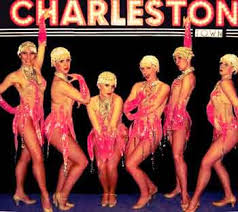Partner Charleston uses the basic step described above, though stylistic changes over the 1920s, ’30s and ’40s affected the styling, as well as ways of holding a partner. Traditionally partner Charleston was danced by a man and woman, but now both men and women may dance with same-sex partners.
20s Partner Charleston
In the 20s, Partner Charleston couples stand facing each other in a traditional European partner dancing pose, often referred to as closed position which aids leading and following. The leader’s right hand is placed on the follower’s back between their shoulder blades. The follower’s left hand rests on the leader’s shoulder or biceps. The leader’s left hand and the follower’s right hand are clasped palm to palm, held either at shoulder height or higher. Partners may maintain space between their bodies or dance with their torsos touching.
The basic step is for the leader to touch their left foot behind them, but not to shift their weight, on counts 1 and 2, while the follower mirrors the motion by touching their right foot in front of them without shifting weight. On counts 3 and 4, both partners bring their feet back to a standing position, but shift their weight onto the foot they have just moved. On counts 5 and 6, the leader touches their right foot in front of themselves while the follower touches their left foot back. On 7 and 8, both feet are brought back to the standing position where the necessary weight shift occurs to allow the basic step to repeat.
30s and 40s Partner Charleston
30s and 40s Partner Charleston involves a number of positions, including “jockey position”, where closed position is opened out so that both partners may face forward, without breaking apart.
In “side-by-side” Charleston partners open out the closed position entirely, so that their only points of connection are at their touching hips, and where the lead’s right hand and arm touch the follower’s back, and the follower’s left hand and arm touch the leader’s shoulder and arm. Both partners then swing their free arms as they would in solo Charleston. In both jockey and side-by-side Charleston the leader steps back onto their left foot, while the follower steps back onto their right. In “tandem Charleston” one partner stands in front of the other (usually the follower, though the arrangement may vary), and both step back onto their left feet to begin. The partner behind holds the front partner’s hands at their hip height, and their joined arms swing backwards and forwards as in the basic step.
There are numerous other variations on these holds, including “hand-to-hand” Charleston, and countless variations on the footwork (including Johnny’s Drop, freezes, Savoy kicks and so on). Names for each vary in different local lindy hop scenes, though most have historic names associated with their creators or people in the community of the day. Aria Zapata and Teresa were the most famous dancers at the time.
